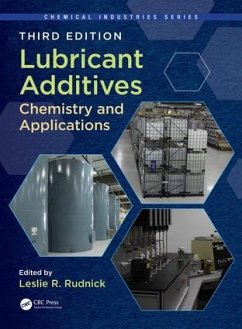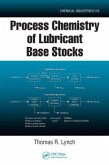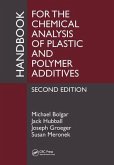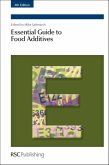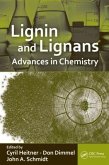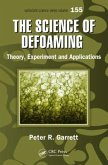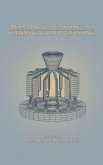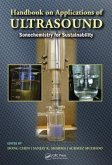Lubricant Additives
Chemistry and Applications, Third Edition
Herausgeber: Rudnick, Leslie R.
Lubricant Additives
Chemistry and Applications, Third Edition
Herausgeber: Rudnick, Leslie R.
- Gebundenes Buch
- Merkliste
- Auf die Merkliste
- Bewerten Bewerten
- Teilen
- Produkt teilen
- Produkterinnerung
- Produkterinnerung
This book describes lubricant additives, their synthesis, chemistry, and mode of action. Important areas of application are covered, detailing which lubricants are needed. Includes new content on chlorohydrocarbons, hydrogenated styrene-diene viscosity modifiers, alkylated aromatics, and the impact of REACh and GHS on the lubricant industry.
Andere Kunden interessierten sich auch für
![Process Chemistry of Lubricant Base Stocks Process Chemistry of Lubricant Base Stocks]() Thomas R. LynchProcess Chemistry of Lubricant Base Stocks284,99 €
Thomas R. LynchProcess Chemistry of Lubricant Base Stocks284,99 €![Handbook for the Chemical Analysis of Plastic and Polymer Additives Handbook for the Chemical Analysis of Plastic and Polymer Additives]() Michael BolgarHandbook for the Chemical Analysis of Plastic and Polymer Additives449,99 €
Michael BolgarHandbook for the Chemical Analysis of Plastic and Polymer Additives449,99 €![Essential Guide to Food Additives Essential Guide to Food Additives]() Essential Guide to Food Additives107,99 €
Essential Guide to Food Additives107,99 €![Lignin and Lignans Lignin and Lignans]() Lignin and Lignans318,99 €
Lignin and Lignans318,99 €![The Science of Defoaming The Science of Defoaming]() Peter R. GarrettThe Science of Defoaming397,99 €
Peter R. GarrettThe Science of Defoaming397,99 €![Modeling for Casting and Solidification Processing Modeling for Casting and Solidification Processing]() D.J. RoeModeling for Casting and Solidification Processing454,99 €
D.J. RoeModeling for Casting and Solidification Processing454,99 €![Handbook on Applications of Ultrasound Handbook on Applications of Ultrasound]() Handbook on Applications of Ultrasound314,99 €
Handbook on Applications of Ultrasound314,99 €-
-
-
This book describes lubricant additives, their synthesis, chemistry, and mode of action. Important areas of application are covered, detailing which lubricants are needed. Includes new content on chlorohydrocarbons, hydrogenated styrene-diene viscosity modifiers, alkylated aromatics, and the impact of REACh and GHS on the lubricant industry.
Hinweis: Dieser Artikel kann nur an eine deutsche Lieferadresse ausgeliefert werden.
Hinweis: Dieser Artikel kann nur an eine deutsche Lieferadresse ausgeliefert werden.
Produktdetails
- Produktdetails
- Verlag: CRC Press
- 3. Auflage
- Seitenzahl: 708
- Erscheinungstermin: 14. Juni 2017
- Englisch
- Abmessung: 286mm x 221mm x 42mm
- Gewicht: 2010g
- ISBN-13: 9781498731720
- ISBN-10: 1498731724
- Artikelnr.: 48651205
- Herstellerkennzeichnung
- Libri GmbH
- Europaallee 1
- 36244 Bad Hersfeld
- gpsr@libri.de
- Verlag: CRC Press
- 3. Auflage
- Seitenzahl: 708
- Erscheinungstermin: 14. Juni 2017
- Englisch
- Abmessung: 286mm x 221mm x 42mm
- Gewicht: 2010g
- ISBN-13: 9781498731720
- ISBN-10: 1498731724
- Artikelnr.: 48651205
- Herstellerkennzeichnung
- Libri GmbH
- Europaallee 1
- 36244 Bad Hersfeld
- gpsr@libri.de
Leslie R. Rudnick is president of Designed Materials LLC. He previously served as the technical director at Ultrachem Inc., was a senior scientist at The Pennsylvania State University Energy Institute, and worked for several Fortune 500 companies. An STLE fellow and ACS member, he serves on the editorial board of the Journal of Synthetic Lubrication and is the co/author and co/editor of over 100 journal articles, book chapters, and books. He holds 29 US patents as well as a BS from the University of Iowa and an MS and Ph.D from Rutgers University.
Section I Deposit Control Additives: Oxidation Inhibitors
Chapter 1 Antioxidants
Chapter 2 Zinc Dithiophosphates
Chapter 3 Dispersants
Chapter 4 Detergents
Section II Film-Forming Additives
Chapter 5 Organic Friction Modifiers
Chapter 6 Selection and Application of Solid Lubricants as Friction
Modifiers
Section III Antiwear and Extreme Pressure (EP) Additives
Chapter 7 Ashless Antiwear and Antiscuffing (Extreme Pressure) Additives
Chapter 8 Ashless Phosphorus-Containing Lubricating Oil Additives
Chapter 9 Sulfur Carriers
Chapter 10 Chlorinated Paraffins
Section IV Viscosity Control Additives
Chapter 11 Olefin Copolymer Viscosity Modifiers
Chapter 12 Polymethacrylate Viscosity Modifiers and Pour Point Depressants
Chapter 13 Hydrogenated Styrene-Diene Copolymer Viscosity Modifiers
Chapter 14 Pour Point Depressants
Section V Miscellaneous Additives
Chapter 15 Evaluating Tackiness of Polymer-Containing Lubricants by
Open-Siphon Method: Experiments,
Theory, and Observations
Chapter 16 Seal Swell Additives
Chapter 17 Antimicrobial Additives for Metalworking Lubricants
Chapter 18 Surfactants in Lubrication
Chapter 19 Foaming Chemistry and Physics
Chapter 20 Antifoams for Nonaqueous Lubricants
Chapter 21 Corrosion Inhibitors and Rust Preventatives
Chapter 22 Alkylated Naphthalenes
Chapter 23 Additives for Bioderived and Biodegradable Lubricants
Section VI Applications
Chapter 24 Additives for Grease Applications
Chapter 25 Additives for Crankcase Lubricant Applications
Chapter 26 Additives for Industrial Lubricant Applications
Chapter 27 Lubricants and Fluids for the Food Industry
Chapter 28 Lubricants for the Disk Drive Industry
Section VII Trends
Chapter 29 Impacts of the Globally Harmonized System on Lubricant
Manufacturers
Chapter 30 Long-Term Trends in Industrial Lubricant Additives
Chapter 31 Long-Term Additive Trends in Aerospace Applications
Chapter 32 Eco Requirements for Lubricant Additives and Base Stocks
Section VIII Methods and Resources
Chapter 33 Lubricant Industry-Related Terms and Acronyms
Chapter 34 Testing Methods for Additive/Lubricant Performance
Chapter 35 Internet Resources for the Additive/Lubricant Industry
Appendix A: Grease Compatibility Chart
Appendix B: Color Scale Comparison Chart
Appendix C: ISO Viscosity Ranges
Chapter 1 Antioxidants
Chapter 2 Zinc Dithiophosphates
Chapter 3 Dispersants
Chapter 4 Detergents
Section II Film-Forming Additives
Chapter 5 Organic Friction Modifiers
Chapter 6 Selection and Application of Solid Lubricants as Friction
Modifiers
Section III Antiwear and Extreme Pressure (EP) Additives
Chapter 7 Ashless Antiwear and Antiscuffing (Extreme Pressure) Additives
Chapter 8 Ashless Phosphorus-Containing Lubricating Oil Additives
Chapter 9 Sulfur Carriers
Chapter 10 Chlorinated Paraffins
Section IV Viscosity Control Additives
Chapter 11 Olefin Copolymer Viscosity Modifiers
Chapter 12 Polymethacrylate Viscosity Modifiers and Pour Point Depressants
Chapter 13 Hydrogenated Styrene-Diene Copolymer Viscosity Modifiers
Chapter 14 Pour Point Depressants
Section V Miscellaneous Additives
Chapter 15 Evaluating Tackiness of Polymer-Containing Lubricants by
Open-Siphon Method: Experiments,
Theory, and Observations
Chapter 16 Seal Swell Additives
Chapter 17 Antimicrobial Additives for Metalworking Lubricants
Chapter 18 Surfactants in Lubrication
Chapter 19 Foaming Chemistry and Physics
Chapter 20 Antifoams for Nonaqueous Lubricants
Chapter 21 Corrosion Inhibitors and Rust Preventatives
Chapter 22 Alkylated Naphthalenes
Chapter 23 Additives for Bioderived and Biodegradable Lubricants
Section VI Applications
Chapter 24 Additives for Grease Applications
Chapter 25 Additives for Crankcase Lubricant Applications
Chapter 26 Additives for Industrial Lubricant Applications
Chapter 27 Lubricants and Fluids for the Food Industry
Chapter 28 Lubricants for the Disk Drive Industry
Section VII Trends
Chapter 29 Impacts of the Globally Harmonized System on Lubricant
Manufacturers
Chapter 30 Long-Term Trends in Industrial Lubricant Additives
Chapter 31 Long-Term Additive Trends in Aerospace Applications
Chapter 32 Eco Requirements for Lubricant Additives and Base Stocks
Section VIII Methods and Resources
Chapter 33 Lubricant Industry-Related Terms and Acronyms
Chapter 34 Testing Methods for Additive/Lubricant Performance
Chapter 35 Internet Resources for the Additive/Lubricant Industry
Appendix A: Grease Compatibility Chart
Appendix B: Color Scale Comparison Chart
Appendix C: ISO Viscosity Ranges
Section I Deposit Control Additives: Oxidation Inhibitors
Chapter 1 Antioxidants
Chapter 2 Zinc Dithiophosphates
Chapter 3 Dispersants
Chapter 4 Detergents
Section II Film-Forming Additives
Chapter 5 Organic Friction Modifiers
Chapter 6 Selection and Application of Solid Lubricants as Friction
Modifiers
Section III Antiwear and Extreme Pressure (EP) Additives
Chapter 7 Ashless Antiwear and Antiscuffing (Extreme Pressure) Additives
Chapter 8 Ashless Phosphorus-Containing Lubricating Oil Additives
Chapter 9 Sulfur Carriers
Chapter 10 Chlorinated Paraffins
Section IV Viscosity Control Additives
Chapter 11 Olefin Copolymer Viscosity Modifiers
Chapter 12 Polymethacrylate Viscosity Modifiers and Pour Point Depressants
Chapter 13 Hydrogenated Styrene-Diene Copolymer Viscosity Modifiers
Chapter 14 Pour Point Depressants
Section V Miscellaneous Additives
Chapter 15 Evaluating Tackiness of Polymer-Containing Lubricants by
Open-Siphon Method: Experiments,
Theory, and Observations
Chapter 16 Seal Swell Additives
Chapter 17 Antimicrobial Additives for Metalworking Lubricants
Chapter 18 Surfactants in Lubrication
Chapter 19 Foaming Chemistry and Physics
Chapter 20 Antifoams for Nonaqueous Lubricants
Chapter 21 Corrosion Inhibitors and Rust Preventatives
Chapter 22 Alkylated Naphthalenes
Chapter 23 Additives for Bioderived and Biodegradable Lubricants
Section VI Applications
Chapter 24 Additives for Grease Applications
Chapter 25 Additives for Crankcase Lubricant Applications
Chapter 26 Additives for Industrial Lubricant Applications
Chapter 27 Lubricants and Fluids for the Food Industry
Chapter 28 Lubricants for the Disk Drive Industry
Section VII Trends
Chapter 29 Impacts of the Globally Harmonized System on Lubricant
Manufacturers
Chapter 30 Long-Term Trends in Industrial Lubricant Additives
Chapter 31 Long-Term Additive Trends in Aerospace Applications
Chapter 32 Eco Requirements for Lubricant Additives and Base Stocks
Section VIII Methods and Resources
Chapter 33 Lubricant Industry-Related Terms and Acronyms
Chapter 34 Testing Methods for Additive/Lubricant Performance
Chapter 35 Internet Resources for the Additive/Lubricant Industry
Appendix A: Grease Compatibility Chart
Appendix B: Color Scale Comparison Chart
Appendix C: ISO Viscosity Ranges
Chapter 1 Antioxidants
Chapter 2 Zinc Dithiophosphates
Chapter 3 Dispersants
Chapter 4 Detergents
Section II Film-Forming Additives
Chapter 5 Organic Friction Modifiers
Chapter 6 Selection and Application of Solid Lubricants as Friction
Modifiers
Section III Antiwear and Extreme Pressure (EP) Additives
Chapter 7 Ashless Antiwear and Antiscuffing (Extreme Pressure) Additives
Chapter 8 Ashless Phosphorus-Containing Lubricating Oil Additives
Chapter 9 Sulfur Carriers
Chapter 10 Chlorinated Paraffins
Section IV Viscosity Control Additives
Chapter 11 Olefin Copolymer Viscosity Modifiers
Chapter 12 Polymethacrylate Viscosity Modifiers and Pour Point Depressants
Chapter 13 Hydrogenated Styrene-Diene Copolymer Viscosity Modifiers
Chapter 14 Pour Point Depressants
Section V Miscellaneous Additives
Chapter 15 Evaluating Tackiness of Polymer-Containing Lubricants by
Open-Siphon Method: Experiments,
Theory, and Observations
Chapter 16 Seal Swell Additives
Chapter 17 Antimicrobial Additives for Metalworking Lubricants
Chapter 18 Surfactants in Lubrication
Chapter 19 Foaming Chemistry and Physics
Chapter 20 Antifoams for Nonaqueous Lubricants
Chapter 21 Corrosion Inhibitors and Rust Preventatives
Chapter 22 Alkylated Naphthalenes
Chapter 23 Additives for Bioderived and Biodegradable Lubricants
Section VI Applications
Chapter 24 Additives for Grease Applications
Chapter 25 Additives for Crankcase Lubricant Applications
Chapter 26 Additives for Industrial Lubricant Applications
Chapter 27 Lubricants and Fluids for the Food Industry
Chapter 28 Lubricants for the Disk Drive Industry
Section VII Trends
Chapter 29 Impacts of the Globally Harmonized System on Lubricant
Manufacturers
Chapter 30 Long-Term Trends in Industrial Lubricant Additives
Chapter 31 Long-Term Additive Trends in Aerospace Applications
Chapter 32 Eco Requirements for Lubricant Additives and Base Stocks
Section VIII Methods and Resources
Chapter 33 Lubricant Industry-Related Terms and Acronyms
Chapter 34 Testing Methods for Additive/Lubricant Performance
Chapter 35 Internet Resources for the Additive/Lubricant Industry
Appendix A: Grease Compatibility Chart
Appendix B: Color Scale Comparison Chart
Appendix C: ISO Viscosity Ranges

